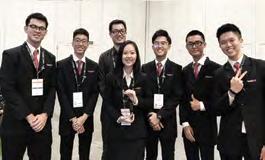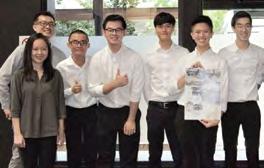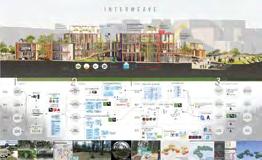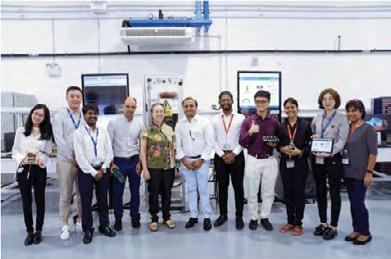
10 minute read
IES Prestigious Engineering Achievement Awards 2020: Recipients and Project Descriptions The winning projects are in four categories
IES UPDATE
RECIPIENTS AND PROJECT DESCRIPTIONS
The winning projects are in four categories - Applied Research & Development, Engineering Projects, Technology Innovation, and Young Creators.
At the conclusion of the National Engineers Day on 21 November last year, the winners of the IES Prestigious Engineering Achievement Awards 2020 were also announced, recognising the outstanding contributions of local engineers to advancing engineering and enhancing quality of life of Singaporeans. A record number of 50 submissions were received for consideration, an indication of the expanse of engineering innovations being developed in Singapore. The winning projects demonstrated excellence in impacting lives, society and economy, and were judged based on the resourcefulness in the planning and solving of design problems; pioneering use of materials and methods; innovations in planning, design and construction; as well as unique aspects and aesthetic values.
All photos and images have been adapted from submissions by the project teams, which were broadcast during the NED 2020 – EIC Prize Announcement Ceremony livestream on 21 November 2020.
CATEGORY: APPLIED RESEARCH AND DEVELOPMENT

Solid State Transformer for Energy Grid 2.0 by Energy Research Institute @ NTU From AC-generation and AC-loads, the distribution power grid is rapidly transitioning to AC/DC distributed generation and DC-loads. This shift will create massive power imbalances at distribution networks leading to frequent disruptions. Solid State Transformers (SST) developed at NTU will seamlessly integrate loads and energy resources irrespective of these being AC or DC. These multi-functional SSTs will decouple DC-generation or loads from the main grid and prevent them from causing any power transfer or power quality issues.

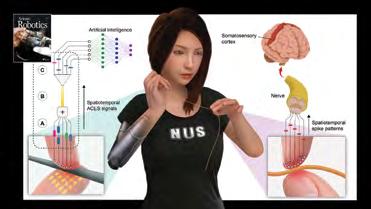
Neuro-inspired Electronic Skin Nervous System for Intelligent Autonomous Robotics by NUS Engineering Benjamin Tee and his team at NUS have developed an artificial nervous system called ACES that enables ultrafast electronic skins. The system can touch and discriminate object properties 10 times faster than the blink of a human eye and can scale to hundreds of thousands of sensors without sacrificing speed. This technology will impact lives by advancing prosthetics and robotics technology.
CATEGORY: APPLIED RESEARCH AND DEVELOPMENT
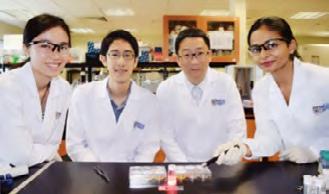

Small-Scale Wireless Bioelectronics for Remote-controlled Phototherapy by NUS Engineering Current phototherapy is limited to treating diseases near the body surface due to the low penetration of light through biological tissues. Professor Zhang Yong and Dr John Ho from NUS have developed a way to wirelessly deliver light into deep regions of the body to activate light-sensitive drugs for photodynamic therapy. This approach provides significant advantages for treating diseases using light in previously inaccessible regions of the body, which may lead to more effective ways to treat cancer and other diseases.

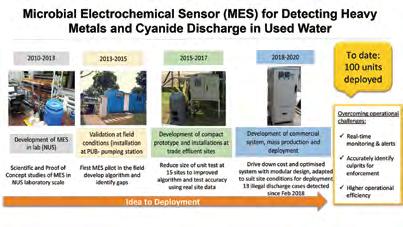
Microbial Electrochemical Sensor (MES) for Detecting Heavy Metals and Cyanide Discharge in Used Water by PUB Pollutants such as heavy metals and cyanide are tightly regulated in Singapore, as these can affect the downstream biological treatment processes in our water reclamation plants. PUB’s monitoring approach comprises routine sampling as well as ad-hoc inspections to ensure that any discharge complies with regulations. In this R&D project, the team developed a real-time toxicity sensor for heavy metals and cyanide through a rigorous process of scientific testing in the laboratory, field trials, and eventually development of a compact system the size of a mini-fridge. Today, the MES system has been deployed in 100 industrial sites in Singapore as part of the continuous water toxicity monitoring regime in PUB.
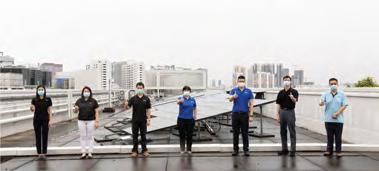

Development of End-to-end Pilot Scale Recycling Process for Recovery of All Materials from Full-size Discarded
Photovoltaic Modules by Singapore Polytechnic Currently, majority of the end-of-life or defective modules end up in landfills, posing potential danger to the environment due to the leaching of toxic heavy metals (such as lead and silver) into ground water. The team has successfully developed a patented technology for recovering all the valuable materials from crystalline silicon PV modules with green chemistry. Having been demonstrated in the laboratory with full sized commercial modules measuring 1.7 m x 1 m, the solution is ready to move beyond the laboratory, and into pilot testing with funding support from the Ministry of National Development and the National Environment Agency.
CATEGORY: ENGINEERING PROJECTS

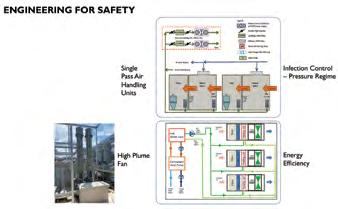
National Centre for Infectious Diseases, Singapore by CPG Consultants The National Center for Infectious Diseases (NCID) is a purpose built healthcare facility to handle infectious outbreak. The building services design is challenging as an isolation facility and also meeting the prevailing Green Mark standard. To handle air borne infections, single pass air-conditioning is provided to avoid contamination within the facility and also to the occupants in the neighbourhood.


Hunter Armoured Fighting Vehicle by Defence Science and Technology Agency (DSTA), Singapore Army and ST Engineering The Hunter Armoured Fighting Vehicle (AFV), locally designed and developed by DSTA with the Singapore Army and ST Engineering, is the Army's first fully-digitalised fighting platform. It is the most advanced AFV in its weight class and provides Singapore's armoured forces with greater firepower, survivability, mobility, and networked warfighting capabilities, while enabling a four-fold increase in area of influence and requiring less manpower to operate. In the pursuit of these objectives, the team introduced many first-of-its kind innovations and spearheaded new design paradigms, while transforming the Army’s processes and the local defence industry.
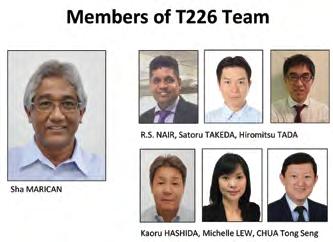

T226 of Thomson East Coast Line, Marina Bay Station by Kiso-Jiban Singapore Project T226 of Thomson East Coast Line, Marina Bay Station, will create an enormous benefit of connectivity for the public, by integrating three MRT lines. In addition to the presence of existing MRT structures and the need to maintain train services, this complex engineering project posed tremendous challenges to engineers as the site is located on reclaimed land and the new tunnels are deep, up to 40m below ground. The team successfully implemented innovative solutions like Horizontal Jet Grouting, purpose-built Rectangular Shield Machine and Ground Freezing which is the first to be used for a rail project in Singapore that is also environmentally friendly.
CATEGORY: ENGINEERING PROJECTS
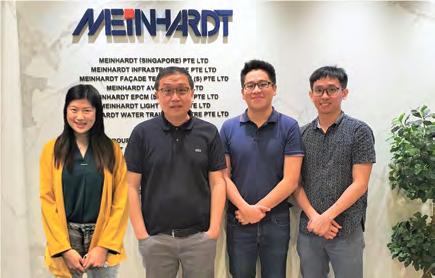
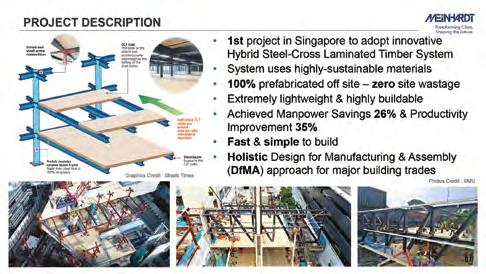
Singapore Management University Connexion by Meinhardt Singapore The fast track project optimised the principles of Design for Manufacturing and Assembly (DfMA) for Civil & Structural, Mechanical & Electrical and architectural facade work, resulting in substantial improvement in manpower productivity and enabling timely completion. The primary structural solution adopted an innovative hybrid steel-cross laminated timber floor system that advocates 100 per cent fabrication off-site, is highly buildable, sustainable and new in the local built environment. The extensive use of pre-fabrication for the M&E systems and facade further enhanced construction productivity and safety on-site.


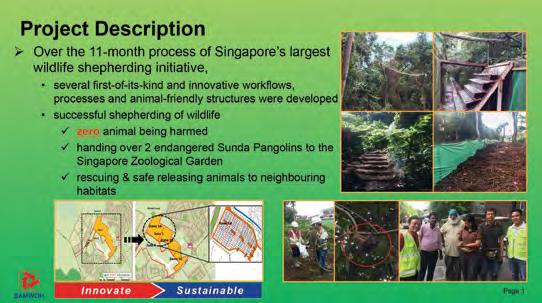
Largest Wildlife Shepherding in Singapore Using Innovative Engineering Solutions by Samwoh Corporation In 2016, Urban Redevelopment Authority (URA) collaborated with Samwoh to conduct land preparation work of a 300,000 m2 secondary forest in the vicinity of Yio Chu Kang and Lentor Drive. Knowing that it was the natural habitat of the wildlife, the project team put in due care and consideration of the animals’ safety and wellbeing. The deployment of numerous innovative engineering solutions, meticulous planning and systematic execution of the project team contributed to the successful execution of the largest wildlife shepherding initiative in Singapore with no animals being harmed over this 11-month operation. In the process, two endangered Sunda pangolins were handed over to the Singapore Zoological Gardens and some animals were released safely to the neighbouring habitats.
CATEGORY: TECHNOLOGY INNOVATION
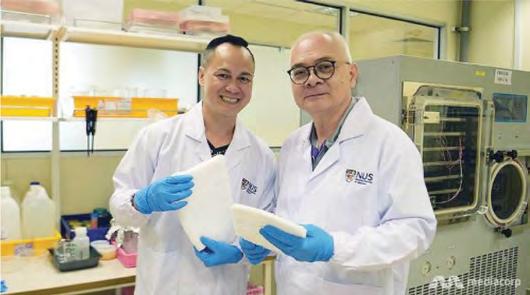
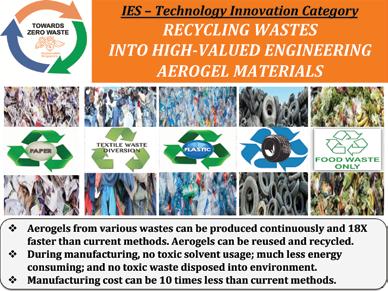
Recycling Various Wastes into High-Valued Engineering Aerogel Materials by NUS Engineering Aerogels from various wastes can be produced continuously and 18 times faster than current methods. Aerogels can be reused and recycled. During manufacturing, no toxic solvent is used; much less energy is being consumed; and no toxic waste is disposed into the environment. Manufacturing cost can be 10 times less than current methods.

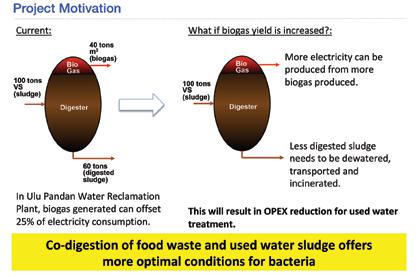
Co-digestion Technology of Food Waste and Used Water Sludge to Enhance Biogas Production by PUB This project conducted by PUB, in collaboration with NEA, EDB and Anaergia Singapore, aimed to harness the synergistic effect of co-digesting food waste and used water sludge to increase biogas production and decrease amount of sludge to be dewatered in PUB’s Water Reclamation Plants. This provides the opportunity for the Water Reclamation Plants to generate enough electricity for process usage, and can potentially allow them to achieve energy self-sufficiency. Through this demonstration, the team validated the synergistic effect of codigesting food waste and used water sludge in the Singapore context, and will implement this in the upcoming Tuas NEXUS project.
CATEGORY: YOUNG CREATORS
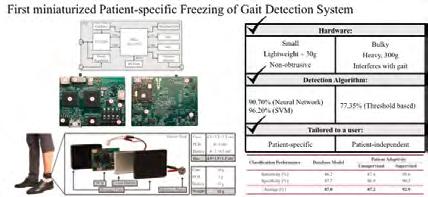

A Wearable, Patient-Adaptive Freezing of Gait Detection System with Biofeedback Cueing for Parkinson’s
Disease Patients by NUS Engineering Freezing of Gait (FoG) is a common motor-related impairment among Parkinson’s disease patients, which substantially reduces their quality of life and puts them at risk of falls. In this work, a wearable patient-specific FoG detection system is developed to provide timely biofeedback cues and hence help them regain control over their gait. To achieve such an integration, features with low computational load are selected and dedicated hardware is designed that limits area and memory utilisation. In addition, the system is capable of learning in real time and thus allows the system to adapt to a patient during run-time.
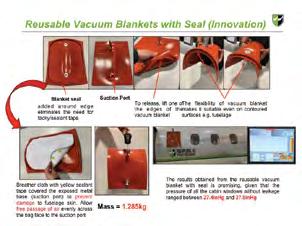
Air Leakage Vacuum-Assisted Detection System without Aircraft Cabin Pressurisation by Republic Polytechnic This project focuses on the design and development of a vacuum-assisted air leakage detection system that is capable of detecting air leaks around doors, windows and access panels of cabins without air pressurisation. Apart from the new Reusable Flexible Vacuum Blanket with Seal, four innovative methods including Particle Velocity, Infrared Thermography, Ultrasound and Smoke Streamlines have been designed and validated in a demonstration aircraft cabin. These newly-developed methods can greatly benefit the aviation industry and aircraft maintenance centres, as well as other industries (e.g., transportation, shipyard and buildings) by providing more effective and time-saving air leakage detection on windows and doors of trains, buses, ships, and buildings.
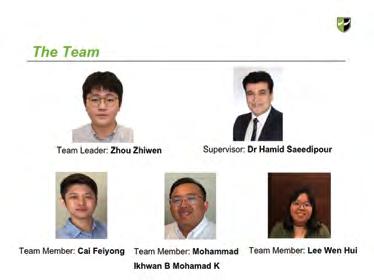
Interweave by Singapore Polytechnic and NUS Architecture The Interweave aims to disrupt the construction of new buildings in Singapore by utilising the Continuous Multi-Objective Computational Approach for a more environmentally and socially sustainable future. The team formulated a leading-edge Multi-Objective Continuous Computational Workflow approach that uses readily available or self-sourced datasets with various software to automatically iterate, compare and decide on the best approach between various disciplines, namely Civil, Mechanical, Electrical and Plumbing, and Architecture, not only enabling more environmentally friendly buildings in the future, but also providing an industry of professionals an environment to work in an interdisciplinary system. The Interweave plans to set a precedence of buildings that engages the community, yet is commercially-viable and functional, with businesses and offices beneficial to one another, for instance, in technology trials, or material production.
